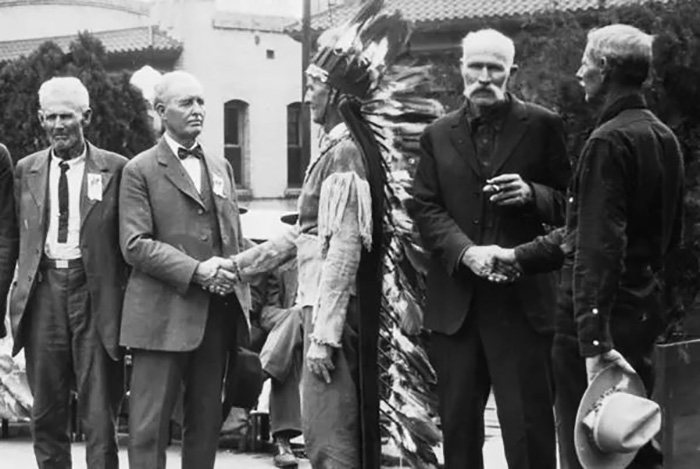Herman Lehmann (June 5, 1859 – February 2, 1932) was captured by Indians as a child. He lived first among the Apache and then the Comanche but eventually returned to his family later in life. The phenomenon of a white child raised by Indians made him a notable figure in the United States. He published his autobiography, Nine Years Among the Indians in 1927.
 On May 16, 1870, a raiding party of eight to ten Apaches (probably Lipans) captured Herman Lehmann, who was almost eleven, and his eight-year-old brother, Willie, while they were in the fields at their mother’s request to scare the birds from the wheat. Their two sisters escaped without injury. Willie Lehmann was able to escape, but the Apaches fled with young Herman.
On May 16, 1870, a raiding party of eight to ten Apaches (probably Lipans) captured Herman Lehmann, who was almost eleven, and his eight-year-old brother, Willie, while they were in the fields at their mother’s request to scare the birds from the wheat. Their two sisters escaped without injury. Willie Lehmann was able to escape, but the Apaches fled with young Herman.
For six years, Lehmann lived among the Apache, ranging from central Texas to eastern New Mexico. He learned the skills of the Apache warrior, hunter, and horsemen. Later, Lehmann avenged the killing of his chief by killing a rival Apache medicine man. Fearing for his life, he fled.

Lehmann wandered the frontier for a year, utilizing the survival skills that he had learned during his time with the Apaches, until he encountered a Comanche camp. At first, the Comanches rejected him and threatened to kill him; however, Lehmann’s story of killing the Apache medicine man was verified by another brave, and he was accepted.
With the Comanches Lehman participated in raids against the Tonkawas and even the United States Cavalry, and was among the last Comanche group to surrender and accept relocation to a reservation at Fort Sill, Indian Territory (Oklahoma). Lehmann later remarked “that was the end of Indian ways, our free, roving times which we loved.”
While at Fort Sill, Lehmann became acquainted with the legendary Comanche leader Quanah Parker, who treated him as his adopted son. It was eventually discovered that Lehmann was a white captive, and his family had survived, despite being told otherwise. In 1878 he was taken from the reservation and returned to his family in Texas, most who had given up hope after he had been captured by Indians.
Upon his arrival, neither he nor his mother recognized one another. Lehmann had long believed his family dead, for the Apache had shown him proof during his time of transition to their way of life. It was his sister who found a scar on his arm, which had been caused by her when they were playing with a hatchet.
Throughout his life, Herman Lehmann drifted between two very different cultures. Lehmann was a very popular figure in southwestern Oklahoma and the Texas Hill Country, appearing at county fairs and rodeos.
In his autobiography, Nine Years Among the Indians (1927, edited by J. Marvin Hunter) he requested that the book be written just as he told it. It is one of the finest captivity narratives in American literature, and is still available at most booksellers.



